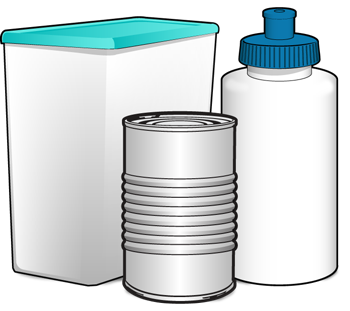For Consumers
FDA Continues to Study BPA
 Get this hi-res art on Flickr. |
 Get Consumer Updates by E-mail
Get Consumer Updates by E-mail
 Share copies of this article (229 KB)
Share copies of this article (229 KB)
On this page
BPA.
It stands for Bisphenol A. It is a chemical used in the production of plastics and resins, such as some water bottles and the coatings of some food cans. It is also used in some consumer goods, such as compact discs and thermal cash register tapes. And it has generated controversy about its impact on human health and development.
The Food and Drug Administration’s assessment is that the scientific evidence at this time does not suggest that the very low levels of human exposure to BPA through the diet are unsafe.
The agency has performed extensive research on BPA, has reviewed hundreds of other studies, and is continuing to address questions and potential concerns raised by certain studies.
FDA scientists have also recently determined that exposure to BPA through foods for infants is much less than had been previously believed and that the trace amounts of the chemical that enter the body, whether it’s an adult or a child, are rapidly metabolized and eliminated.
Dennis M. Keefe, Ph.D., director of FDA’s Office of Food Additive Safety, and other officials at FDA say the agency takes all concerns about BPA seriously and is evaluating them as part of the agency’s ongoing oversight of food safety.
Because of some studies in young animals that raised potential concerns about the safety of BPA, there has been particular concern about its use in infant bottles and training (sippy) cups, FDA has been supporting industry efforts to find alternatives to BPA in the manufacture of these and other products, Keefe says.
Potential Concerns About BPA
BPA has been used since the 1960s to make polycarbonate plastics and epoxy resins. These hard, clear plastics are often used in containers that store food and beverages, such as some water bottles. The resins are also used to protect foods from microbial and other contamination by coating the inside of metal products, such as some food cans.
Research has shown that people are exposed to BPA because small amounts can migrate into the food and beverages from their containers. Reports from some animal studies have raised potential concerns that BPA exposure may cause multiple health problems, including reproductive disorders, diabetes and cardiovascular disease.
There have also been studies that contend that BPA is a hazard to people too. But FDA—as well as the European Food Safety Agency (EFSA)—has carefully assessed these studies and finds no convincing evidence to support that belief.
The regulatory agency must objectively weigh all the evidence, says Keefe. “We make public health decisions based on a careful review of well performed studies, not based on claims or beliefs. We have to perform an unbiased evaluation of the data,” he says.
FDA is continuing its research and monitoring of studies to address uncertainties raised about BPA.
FDA’s Findings
With the support of the National Institute of Environmental Health Sciences (NIEHS) and the National Toxicology Program (NTP), scientists at FDA’s National Center for Toxicological Research (NCTR) have been studying BPA.
The NCTR researchers have been conducting in-depth studies of BPA since September 2008, when a report by the NIEHS and NTP called for more research into the potential toxic effects of BPA on fetuses, infants and children.
NCTR’s findings include:
- The level of BPA from food that could be passed from pregnant mothers to the fetus is so low that it could not be measured. Researchers fed pregnant rodents 100 to 1,000 times more BPA than people are exposed to through food, and could not detect the active form of BPA in the fetus eight hours after the mother’s exposure.
- Exposure to BPA in human infants is from 84 to 92 percent less than previously estimated.
NCTR researchers report that they were able to build mathematical models of what happens to BPA once it’s in the human body. These models showed that BPA is rapidly metabolized and eliminated through feces and urine. They found that BPA is “exactly the opposite” from some other toxins, like dioxin, that can stay in the body’s tissues for months or even years.
The center’s toxicology research has not found evidence of BPA toxicity at low doses in rodent studies, including doses that are still above human exposure levels.
What Can Consumers Do?
Consumers should avoid changes in their food consumption that would prevent good nutrition, particularly for infants.
Here is information for consumers who want to limit their exposure to BPA:
- Plastic containers have recycle codes on the bottom. Some, but not all, plastics that are marked with recycle codes 3 or 7 may be made with BPA.
- Do not put very hot or boiling liquid that you intend to consume in plastic containers made with BPA. BPA levels rise in food when containers/products made with the chemical are heated and come in contact with the food.
- Discard all bottles with scratches, as these may harbor bacteria and, if BPA-containing, lead to greater release of BPA.
This article appears on FDA's Consumer Update page, which features the latest on all FDA-regulated products.
March 30, 2012








